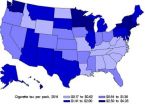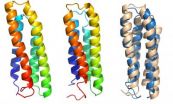(Press-News.org) MINNEAPOLIS – Even mild traumatic brain injury may cause brain damage and thinking and memory problems, according to a study published in the July 16, 2014, online issue of Neurology®, the medical journal of the American Academy of Neurology.
For the study, 44 people with a mild traumatic brain injury and nine people with a moderate traumatic brain injury were compared to 33 people with no brain injury. All of the participants took tests of their thinking and memory skills. At the same time, they had diffusion tensor imaging scans, a type of MRI scan that is more sensitive than traditional MRI for detecting damage to brain cells and helps map fiber tracts that connect brain regions. The people with brain injuries had their scans an average of six days after the injury. A year later, 23 of those with injuries had another scan and took the cognitive tests again.
Compared to the people with no brain injury, those with injuries had brain damage in brain white matter consisting of disruption to nerve axons, those parts of nerve cells that make up white matter and that allow brain cells to transmit messages to each other.
The study found that patient scores on the verbal letter fluency task, a test of thinking and memory skills, were 25 percent lower than in the healthy people. This was strongly related to the imaging measures of white matter damage.
"Most of the studies thus far have focused on people with severe and chronic traumatic brain injury," said study author Andrew Blamire, PhD, of Newcastle University in the United Kingdom. "We studied patients who had suffered clinically mild injuries often from common accidents such as falling from a bicycle, or slow speed car accidents. This finding is especially important, as 90 percent of all traumatic brain injuries are mild to moderate."
One year after the injury, the scores on thinking and memory tests were the same for people with brain injuries and those with no injuries, but there were still areas of brain damage in people with injuries. "These results show that thinking skills were recovering over time," Blamire said. "The areas of brain damage were not as widespread across the brain as previously, but focused in certain areas of the brain, which could indicate that the brain was compensating for the injuries."
INFORMATION:
The study was supported by the Sir Jules Thorn Charitable Trust.
To learn more about traumatic brain injury, please visit http://www.aan.com/patients.
The American Academy of Neurology, an association of more than 28,000 neurologists and neuroscience professionals, is dedicated to promoting the highest quality patient-centered neurologic care. A neurologist is a doctor with specialized training in diagnosing, treating and managing disorders of the brain and nervous system such as Alzheimer's disease, stroke, migraine, multiple sclerosis, brain injury, Parkinson's disease and epilepsy.
For more information about the American Academy of Neurology, visit http://www.aan.com or find us on Facebook, Twitter, Google+ and YouTube.
Even mild traumatic brain injury may cause brain damage
2014-07-16
ELSE PRESS RELEASES FROM THIS DATE:
RNs' delayed retirement boosts US nursing supplies, study finds
2014-07-16
Older registered nurses are working longer than in the past, one reason that the nation's supply of RNs has grown substantially in recent years, according to a new study.
Researchers found that from 1991 to 2012, among registered nurses working at age 50, 24 percent remained working as late as age 69. This compared to 9 percent during the period from 1969 to 1990. The findings are published online by the journal Health Affairs.
"We estimate this trend accounts for about a quarter of an unexpected surge in the supply of registered nurses that the nation has experienced ...
Persistent symptoms following concussion may be posttraumatic stress disorder
2014-07-16
Bottom Line: The long-lasting symptoms that many patients contend with following mild traumatic brain injury (MTBI), also known as concussion, may be posttraumatic disorder (PTSD) and not postconcussion syndrome (PCS).
Authors: Emmanuel Lagarde, Ph.D., of the Université de Bordeaux, France, and colleagues.
Background: Concussion accounts for more than 90 percent of all TBIs, although little is known about prognosis for the injury. The symptoms cited as potentially being part of PCS fall into three areas: cognitive, somatic and emotional. But the interpretation of symptoms ...
Study examines shift in resuscitation practices in military combat hospitals
2014-07-16
Bottom Line: Widespread military adoption of damage control resuscitation (DCR) policies has shifted resuscitation practices at combat hospitals during conflicts.
Author: Nicholas R. Langan, M.D., and colleagues from the Madigan Army Medical Center, Tacoma, Wash.
Background: Operation Iraqi Freedom (OIF) and Operation Enduring Freedom (OEF) are the first prolonged conflicts the United States has been involved in since the Vietnam War. Medical and surgical advances have often emerged from the battlefields. One of the most important advancements in combat trauma care ...
Study: Smoking may contribute to suicide risk
2014-07-16
AUDIO:
People who smoke cigarettes commit suicide at higher rates than those who don't smoke. That's been known for years, but most scientists assumed the reason was that smoking rates were...
Click here for more information.
Cigarette smokers are more likely to commit suicide than people who don't smoke, studies have shown. This reality has been attributed to the fact that people with psychiatric disorders, who have higher suicide rates, also tend to smoke. But new research ...
Cell membrane proteins give up their secrets
2014-07-16
HOUSTON – (July 16, 2014) – Rice University scientists have succeeded in analyzing transmembrane protein folding in the same way they study the proteins' free-floating, globular cousins.
Rice theoretical biologist Peter Wolynes and his team at the university's Center for Theoretical Biological Physics (CTBP) have applied his energy landscape theory to proteins that are hard to view because they live and work primarily inside cell membranes.
The method should increase the technique's value to researchers who study proteins implicated in diseases and possibly in the ...
Are ants the answer to carbon dioxide sequestration?
2014-07-16
Boulder, Colo. – A 25-year-long study published in Geology on 14 July provides the first quantitative measurement of in situ calcium-magnesium silicate mineral dissolution by ants, termites, tree roots, and bare ground. This study reveals that ants are one of the most powerful biological agents of mineral decay yet observed. It may be that an understanding of the geobiology of ant-mineral interactions might offer a line of research on how to "geoengineer" accelerated CO2 consumption by Ca-Mg silicates.
Researcher Ronald Dorn of Arizona State University writes that over ...
Study: Robot-assisted surgery for prostate cancer controls the disease for 10 years
2014-07-16
DETROIT – Robot-assisted surgery to remove cancerous prostate glands is effective in controlling the disease for 10 years, according to a new study led by researchers at Henry Ford Hospital.
The study also suggested that traditional methods of measuring the severity and possible spread of the cancer together with molecular techniques might, with further research, help to create personalized, cost-effective treatment regimens for prostate cancer patients who undergo the surgical procedure.
The findings apply to men whose cancer has not spread beyond the prostate, and the ...
Seeing the glass as half full: Taking a new look at cognition and aging
2014-07-16
From a cognitive perspective, aging is typically associated with decline. As we age, it may get harder to remember names and dates, and it may take us longer to come up with the right answer to a question.
But the news isn't all bad when it comes to cognitive aging, according to a set of three articles in the July 2014 issue of Perspectives in Psychological Science.
Plumbing the depths of the available scientific literature, the authors of the three articles show how several factors — including motivation and crystallized knowledge — can play important roles in supporting ...
Fair cake cutting gets its own algorithm
2014-07-16
The next time your children quibble about who gets to eat which part of a cake, call in some experts on the art of sharing. Mathematician Julius Barbanel of Union College, and political scientist Steven Brams of New York University, both in the US, published an algorithm in Springer's The Mathematical Intelligencer by which they show how to optimally share cake between two people efficiently, in equal pieces and in such a way that no one feels robbed.
The cut-and-choose method to share divisible goods has been regarded as fair and envy-free since Biblical times, when ...
Borneo deforested 30 percent over past 40 years
2014-07-16
Forest cover in Borneo may have declined by up to 30% over the past 40 years, according to a study published July 16, 2014 in the open-access journal PLOS ONE by David Gaveau from the Center for International Forestry Research, Indonesia, and colleagues.
The native forests of Borneo have been increasingly impacted by logging, fire, and conversion to plantations since the early 1970s. Borneo lacks island-wide forest clearance and logging documentation, making forest conservation planning difficult, especially for selectively logged forests that have high conservation potential ...

